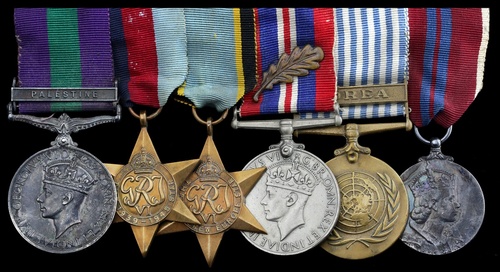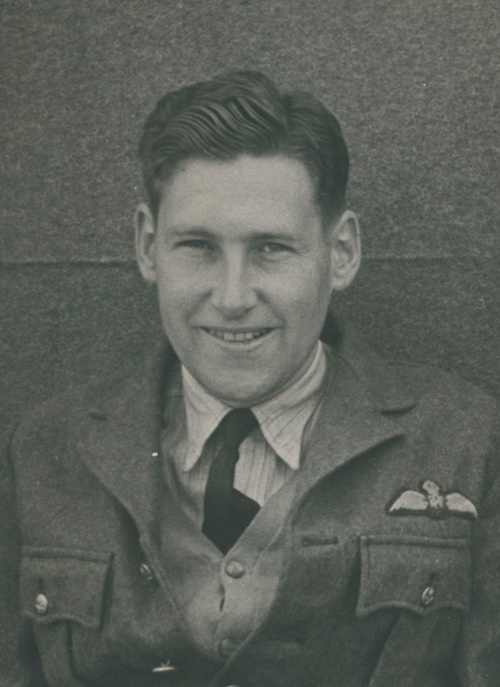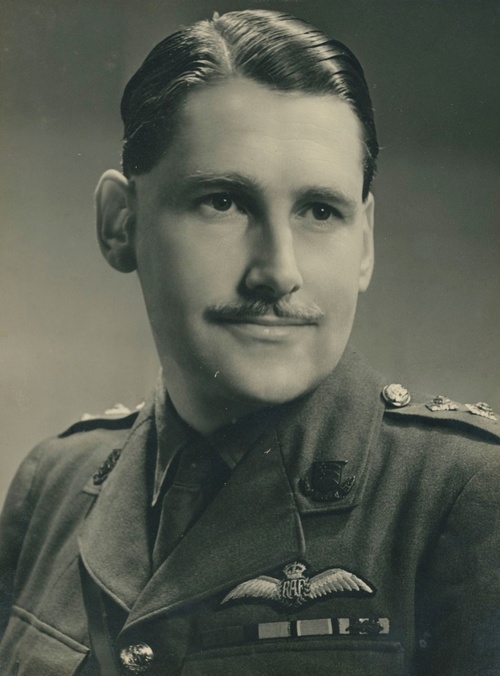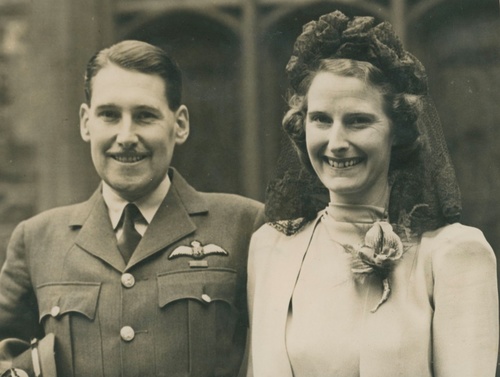Auction: 19002 - Orders, Decorations and Medals
Lot: 164
Sold by Order of a Direct Descendant
An interesting campaign group of six awarded to Lieutenant-Colonel S. G. L. Pepys, Essex Regiment, seconded Royal Air Force, who was pilot of a Blenheim bomber shot down during the Battle of France
Constantly causing consternation amongst his German captors dressed in his Army uniform, he was present at Stalag Luft III during the 'Great Escape' and survived the famous forced march in the final months of the war
General Service 1918-62, 1 clasp, Palestine (Lieut. S. G. L. Pepys. Essex.); 1939-45 Star; Air Crew Europe Star; War Medal 1939-45 with M.I.D. oakleaf; U.N. Korea 1950-54, unnamed as issued; Coronation 1953, unnamed as issued, mounted half-court style as worn, very fine and an unusual combination (6)
Samuel Guy Leslie Pepys was born on 13 December 1915 at Banbury, Oxfordshire, the son of Lieutenant-Colonel A. G. L. Pepys of Coombe Priory, Shaftesbury, Dorset. Educated at Wellington College, Pepys was commissioned 2nd Lieutenant in the Essex Regiment on 29 August 1935. Having then witnessed service in Palestine, he was promoted Lieutenant 29 August 1938, before being transferred to Special Employment on 31 October 1938, whereupon he qualified as a pilot on secondment to the Royal Air Force.
Following the outbreak of the Second World War, Pepys served as a Flying Officer with No. 53 Squadron. In May 1940, the Squadron - equipped with Bristol Blenheim light bombers - was heavily engaged resisting the German onslaught in France, and it was on one such mission flying Blenheim R3691 that Pepys and his crew were shot down near Hesdin in the Pas-de-Calais. His General Questionnaire for British and American Ex-Prisoners of War adds more detail:
'Shot down 5 a.m. on 23/May/40 with Sgt (Obs) Haygreen & A.C. H. Spear (A/G), endeavoured to make south of the Somme. Surrendered to enemy at 0800 hrs near La Broye - having very little food.'
Pepys immediately found himself in a rather precarious position, as recalled by the son of Spear:
'At that time, the Germans couldn't figure out why he was in his Army uniform flying an R.A.F. bomber.'
Initially reported missing, he was confirmed as a Prisoner of War in The Daily Mirror, 22 June 1940, and by Flight Magazine on 27 June 1940. Sent to Oflag IXA at Spangenberg from 10 June 1940-10 July 1940, followed by Stalag Luft I at Barth from 10 July 1940-25 March 1942, Pepys found himself interned in the infamous Stalag Luft III at Sagan, scene of 'The Great Escape,' from 26 March 1942-25 January 1945. Whilst there, he had an interesting discussion with a fellow prisoner, Squadron Leader Rupert Parkhouse:
'About two years later I was in the prison camp talking to Captain Samuel Pepys of the Essex Regiment - he was a direct descendant of the great diarist and he said that during his training at Little Rissington, two Cranwell Cadets had landed downwind and the second one had bounced over him when he was taking off. He said he would certainly like to meet that bastard and tell him what he thought of him, so I told him he could do so now as I was that chap, and I must have been as shaken as he was!'
This is but one event recalled in a 30-minute tape recording with Parkhouse, which was produced on 2 June 1995 and is held by the Imperial War Museum and available online. Parkhouse was subsequently forced to report to the C.F.I. and was severely reprimanded by Squadron-Leader Dermot Boyle:
'He tore me off a most imperial rocket and made me stay overnight, where I was an object of considerable derision to the short service officers who were under instruction there.'
The Great Escape
According to family repute, Pepys, whilst not an escaper, had previous experience as the Quartermaster at Stalag Luft I. He is understood to have assisted in ensuring supplies for the captives from the German authorities and would surely have been a well-known character to the big players in the break. In the obituary of Wing Commander Ken Rees, the last surviving member of the digging team that constructed the tunnel used in March 1944 - and an ex-bomber pilot himself - it is stated that '..the tunnelling in Harry became an occupational therapy to alleviate the boredom and hunger through one of the coldest winters of the past century'.
Interestingly, in his General Questionnaire - completed on 3 May 1945 - Pepys answers 'No' to the vast majority of questions, including references to sabotage. However he did earn a 'mention' for his services whilst a Prisoner of War (London Gazette 28 December 1945, refers).
In late January 1945, Pepys and his fellow prisoners of war were given one hour's notice to collect their meagre belongings and leave the camp as the Soviet Army advanced from the East. They suffered severe privations and terrible winter weather as they were marched westwards by their guards on what became known as 'The Long March'. Pepys spent his final months at a camp at Darmstedt in south-west Germany, being liberated around 2 May 1945.
Returning home, Pepys married Lettuce Gayford Partridge in the Queen's Chapel of St. John the Baptist, in the Precinct of the Savoy, London, on 8 December 1945. Having seen further service during the Korean War and in Hong Kong, where he took up medal collecting, the Lieutenant-Colonel died on 16 June 1970.
Sold together with an original archive comprising:
(i)
Mention in Despatches certificate named to 'Flight Lieutenant S. G. L. Pepys, Royal Air Force' and dated 28 December 1945.
(ii)
The recipient's presentation copy of Tunnel to Freedom by Flight Lieutenant Paul Brickhill, R.A.A.F., signed in ink 'S. Pepys.' to front cover - offering an outstanding contemporary account detailing the astonishing ingenuity and audacity of the 'Great Escape', together with some outstanding photographs of the escapers and tunnels.
(iii)
Coronation 1953 Medal certificate named to 'Major S. G. L. Pepys'.
(iv)
Framed portrait photograph of recipient, 4 portrait photographs of Pepys including 2 with his wife - in full R.A.F. uniform - together with copied research and communication with Mr. Phil Spear.
For the recipient's miniature dress medals, please see Lot 423. For his father's awards, please see Lot 378.
Subject to 20% VAT on Buyer’s Premium. For more information please view Terms and Conditions for Buyers.
Sold for
£1,800
Starting price
£600











